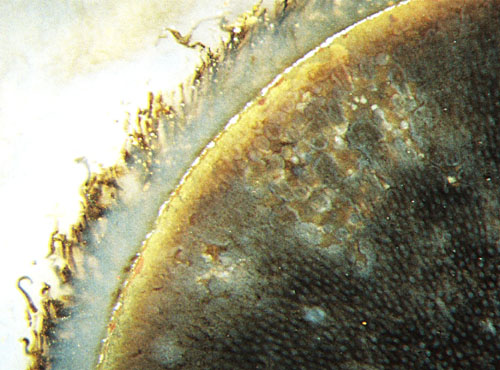Uncommon aspect of Pachytheca
Pachytheca,
a mm-size sphere which lived in the Silurian and Lower
Devonian and would not readily fit into any scheme, has recently been
assigned to the nematophytes
and, together with all nematophytes, put
under the heading Enigmatic Organisms in [1]. (This view is adopted
here
although Pachytheca
is still regarded as some strange type of alga by
others.) It stands out amongst nematophytes as it is the only one with
spherical shape. Specimens are found as coalified brittle fossils at
several locations [2,3], usually as glossy black spheres. If broken or
cut into halves they show a thick spherical shell of radially arranged
tubes. A cut along a central plane of the silicified specimen presented
here is shown in Rhynie
Chert News
1. Apparently, Pachytheca
has never been pictured such that the
radial tubes are seen in cross-section as in Fig.1.

Fig.1: Pachytheca
in Rhynie chert, view on a cut face positioned 1.4mm
off the centre of this spherical organism. Hence, the tubes appear as
cross-sections in the middle of the circle and as inclined
sections
elsewhere The centre of the sphere is above the
picture plane so that one looks from inside the sphere
towards
the cap.
Diameter of the cap 2.5mm.
This picture confirms the visual impression already obtained from the
larger part of the specimen, the half sphere shown in Rhynie
Chert News 1:
The tubes form an essentially close-packed arrangement. The interior of
the tubes, seen as light-coloured dots, appears rather
narrow while the tube walls appear rather thick in the central region,
which probably is an artifact due to preservation and/or imaging.
As observed earlier, approaching cracks do not enter but become
deflected such that they separate the sphere from the surrounding
matrix.
There are other features worth considering: damaged areas inside and a
conspicuous coating around the sphere with a filamentous structure of
rugged aspect.

Fig.2 (right): Pachytheca
with
areas of damage affecting both the
tubes and the gel; detail of Fig.1.
The spherical surface of the cap meets the picture plane at an acute
angle. The incident light is reflected at the crack separating the
sphere from the surrounding matrix, which makes the light-coloured
margin of the circular section seen here.
The damage bears superficial similarity with wood decay
known as pocket rot. Without more detailed investigations
with higher magnification, the cause of the rot is obscure. What seems
to be sure is that the rot is not restricted to either the tubes or the
gel between the tubes, and it does not preferably spread along the
tubes.
Concerning the coating around the sphere, it
seems that an
interpretation as a microbial layer with peculiar outgrowths can be
excluded since a slight tendency towards an alignment of the tangled
filaments can be observed in some places. It seems to be a sheath
somehow
related to Pachytheca,
which is all the more interesting as it
adds another enigma to this still poorly understood fossil. See Rhynie
Chert News 44.
H.-J. Weiss
2010, slightly modified in 2012.
[1] T.N.
Taylor, E.L. Taylor, M. Krings : Paleobotany, Elsevier
2009.
[2] H.
Steur : Pachytheca,
een vreemd, plantaardig bolletje
uit het Devoon, Grondboor & Hamer
58(2004), 52-57.
[3] H. Steur:
Pachytheca,
a strange, vegetable little sphere. http://www.xs4all.nl/~steurh/
 |
 |
36 |





